Microeconomics Report: Analysis of Marvel Entertainment's Business
VerifiedAdded on 2023/01/23
|7
|1267
|87
Report
AI Summary
This report provides a microeconomic analysis of Marvel Entertainment, examining its market structure, which is identified as an oligopoly, characterized by a few dominant firms. The report explores the company's products, including animations, comics, and films, and discusses the impact of government regulations like the Superhuman Registration Acts. It highlights opportunities such as brand recognition and potential for expansion, while also addressing threats like market saturation and competition. The analysis delves into the concept of price elasticity of demand for Marvel's products, suggesting inelasticity. Furthermore, it discusses the impact of new companies entering the market and the cost structures faced by the firm, including the kinked demand curve associated with oligopolies. The report also examines how scarcity, choice, and opportunity cost affect decision-making within the company and concludes with a summary of the key findings, reinforcing Marvel's position in an oligopolistic market and its potential for growth through various strategies, including franchise expansion and Netflix shows.
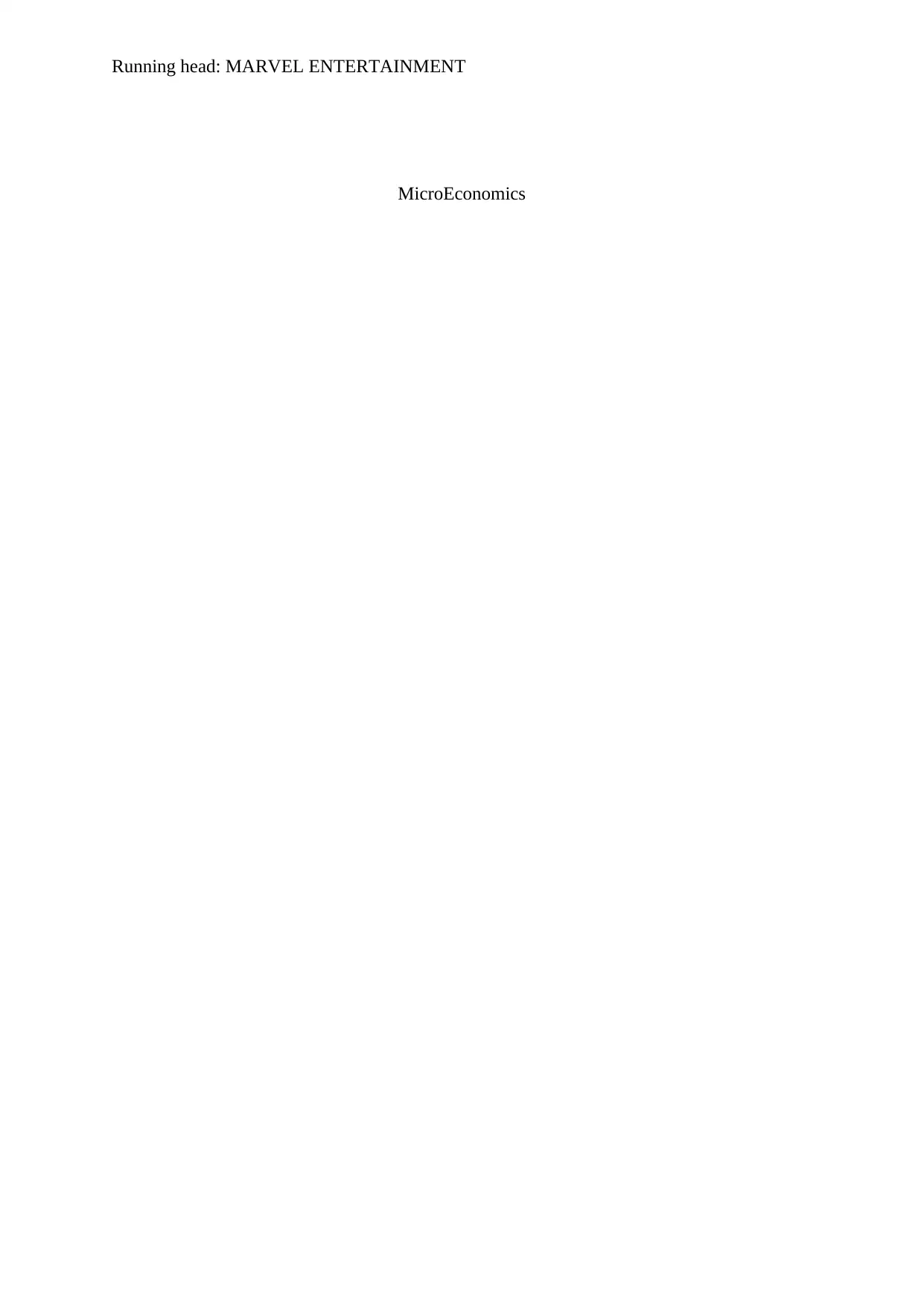
Running head: MARVEL ENTERTAINMENT
MicroEconomics
MicroEconomics
Paraphrase This Document
Need a fresh take? Get an instant paraphrase of this document with our AI Paraphraser
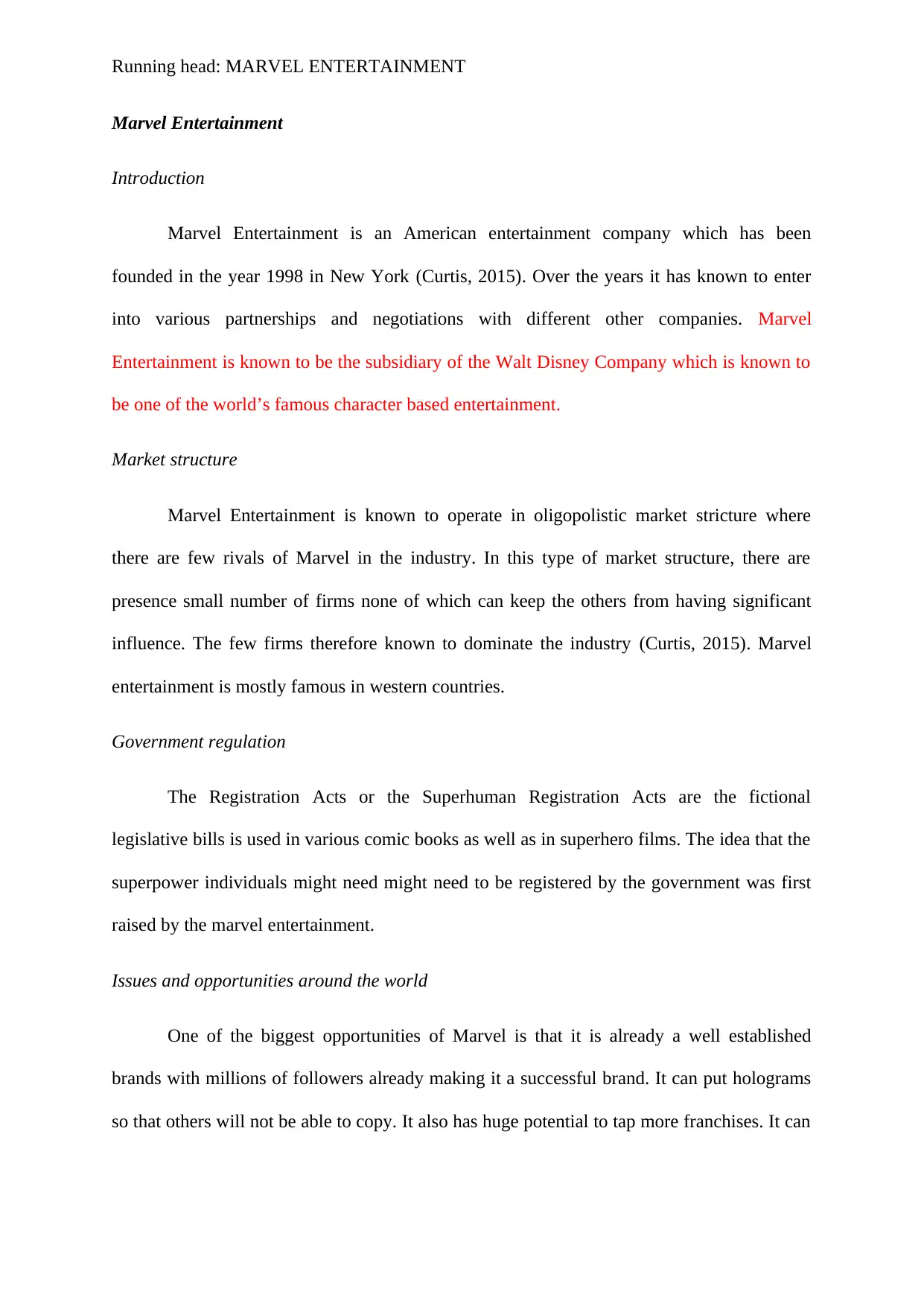
Running head: MARVEL ENTERTAINMENT
Marvel Entertainment
Introduction
Marvel Entertainment is an American entertainment company which has been
founded in the year 1998 in New York (Curtis, 2015). Over the years it has known to enter
into various partnerships and negotiations with different other companies. Marvel
Entertainment is known to be the subsidiary of the Walt Disney Company which is known to
be one of the world’s famous character based entertainment.
Market structure
Marvel Entertainment is known to operate in oligopolistic market stricture where
there are few rivals of Marvel in the industry. In this type of market structure, there are
presence small number of firms none of which can keep the others from having significant
influence. The few firms therefore known to dominate the industry (Curtis, 2015). Marvel
entertainment is mostly famous in western countries.
Government regulation
The Registration Acts or the Superhuman Registration Acts are the fictional
legislative bills is used in various comic books as well as in superhero films. The idea that the
superpower individuals might need might need to be registered by the government was first
raised by the marvel entertainment.
Issues and opportunities around the world
One of the biggest opportunities of Marvel is that it is already a well established
brands with millions of followers already making it a successful brand. It can put holograms
so that others will not be able to copy. It also has huge potential to tap more franchises. It can
Marvel Entertainment
Introduction
Marvel Entertainment is an American entertainment company which has been
founded in the year 1998 in New York (Curtis, 2015). Over the years it has known to enter
into various partnerships and negotiations with different other companies. Marvel
Entertainment is known to be the subsidiary of the Walt Disney Company which is known to
be one of the world’s famous character based entertainment.
Market structure
Marvel Entertainment is known to operate in oligopolistic market stricture where
there are few rivals of Marvel in the industry. In this type of market structure, there are
presence small number of firms none of which can keep the others from having significant
influence. The few firms therefore known to dominate the industry (Curtis, 2015). Marvel
entertainment is mostly famous in western countries.
Government regulation
The Registration Acts or the Superhuman Registration Acts are the fictional
legislative bills is used in various comic books as well as in superhero films. The idea that the
superpower individuals might need might need to be registered by the government was first
raised by the marvel entertainment.
Issues and opportunities around the world
One of the biggest opportunities of Marvel is that it is already a well established
brands with millions of followers already making it a successful brand. It can put holograms
so that others will not be able to copy. It also has huge potential to tap more franchises. It can
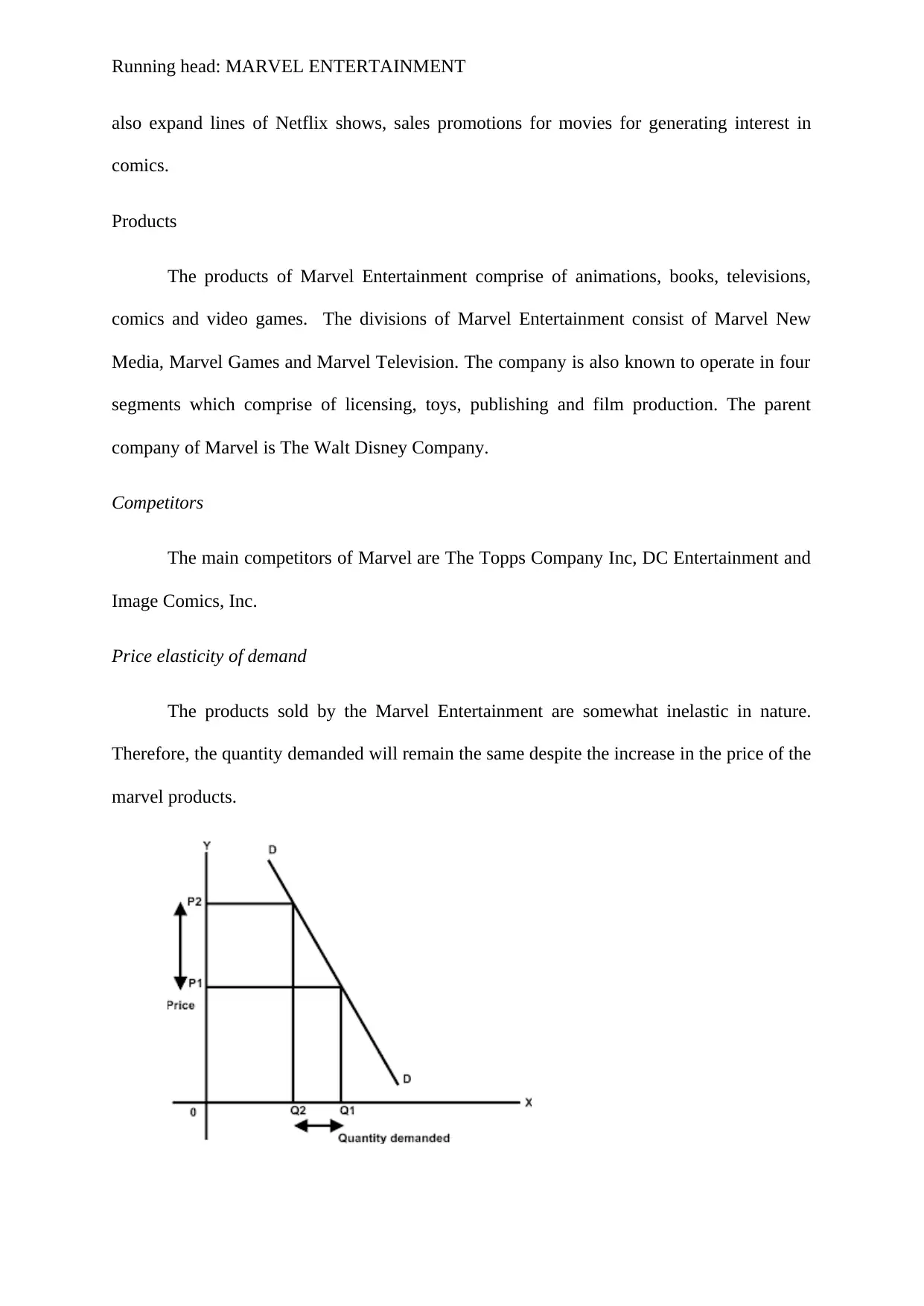
Running head: MARVEL ENTERTAINMENT
also expand lines of Netflix shows, sales promotions for movies for generating interest in
comics.
Products
The products of Marvel Entertainment comprise of animations, books, televisions,
comics and video games. The divisions of Marvel Entertainment consist of Marvel New
Media, Marvel Games and Marvel Television. The company is also known to operate in four
segments which comprise of licensing, toys, publishing and film production. The parent
company of Marvel is The Walt Disney Company.
Competitors
The main competitors of Marvel are The Topps Company Inc, DC Entertainment and
Image Comics, Inc.
Price elasticity of demand
The products sold by the Marvel Entertainment are somewhat inelastic in nature.
Therefore, the quantity demanded will remain the same despite the increase in the price of the
marvel products.
also expand lines of Netflix shows, sales promotions for movies for generating interest in
comics.
Products
The products of Marvel Entertainment comprise of animations, books, televisions,
comics and video games. The divisions of Marvel Entertainment consist of Marvel New
Media, Marvel Games and Marvel Television. The company is also known to operate in four
segments which comprise of licensing, toys, publishing and film production. The parent
company of Marvel is The Walt Disney Company.
Competitors
The main competitors of Marvel are The Topps Company Inc, DC Entertainment and
Image Comics, Inc.
Price elasticity of demand
The products sold by the Marvel Entertainment are somewhat inelastic in nature.
Therefore, the quantity demanded will remain the same despite the increase in the price of the
marvel products.
⊘ This is a preview!⊘
Do you want full access?
Subscribe today to unlock all pages.

Trusted by 1+ million students worldwide
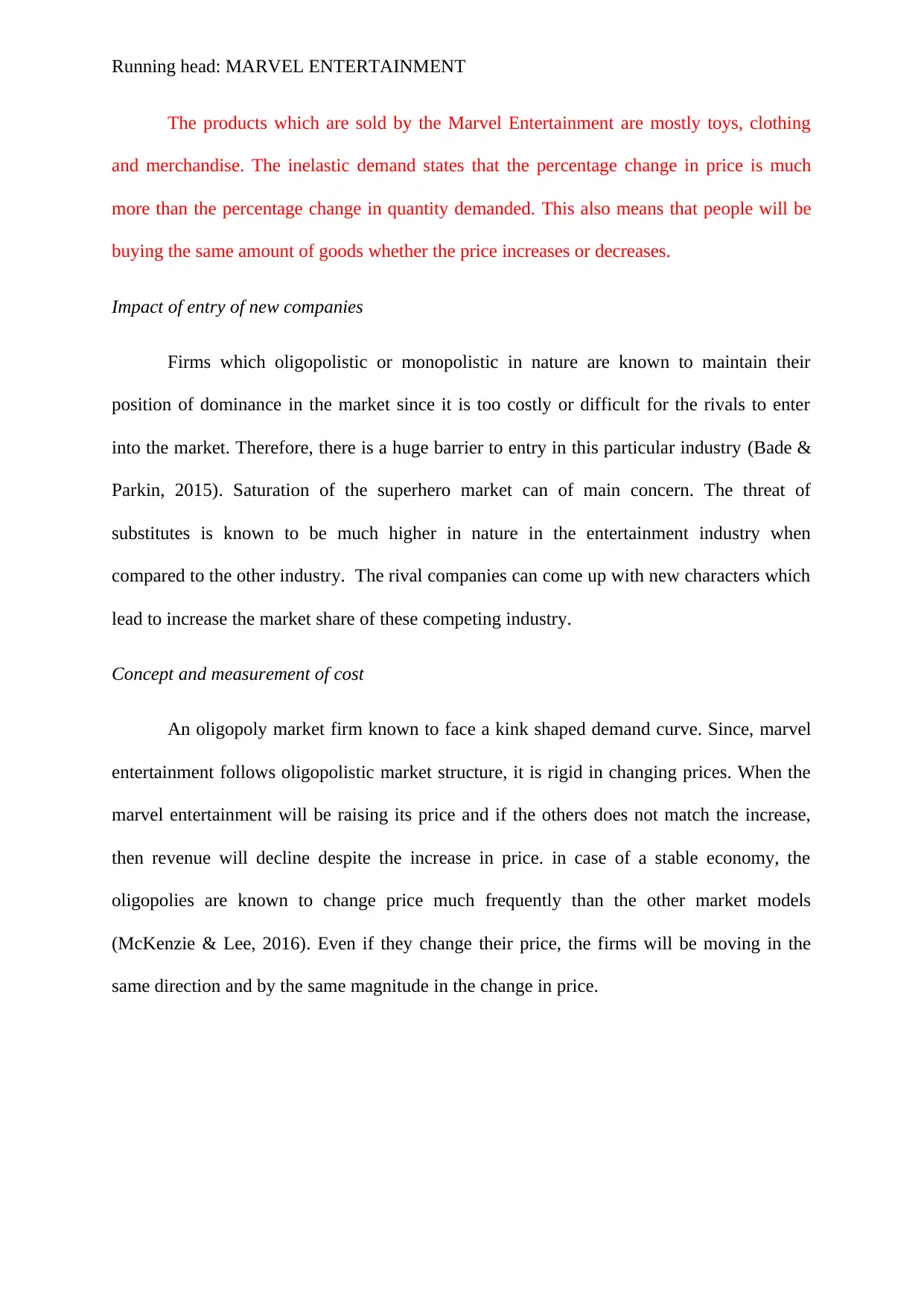
Running head: MARVEL ENTERTAINMENT
The products which are sold by the Marvel Entertainment are mostly toys, clothing
and merchandise. The inelastic demand states that the percentage change in price is much
more than the percentage change in quantity demanded. This also means that people will be
buying the same amount of goods whether the price increases or decreases.
Impact of entry of new companies
Firms which oligopolistic or monopolistic in nature are known to maintain their
position of dominance in the market since it is too costly or difficult for the rivals to enter
into the market. Therefore, there is a huge barrier to entry in this particular industry (Bade &
Parkin, 2015). Saturation of the superhero market can of main concern. The threat of
substitutes is known to be much higher in nature in the entertainment industry when
compared to the other industry. The rival companies can come up with new characters which
lead to increase the market share of these competing industry.
Concept and measurement of cost
An oligopoly market firm known to face a kink shaped demand curve. Since, marvel
entertainment follows oligopolistic market structure, it is rigid in changing prices. When the
marvel entertainment will be raising its price and if the others does not match the increase,
then revenue will decline despite the increase in price. in case of a stable economy, the
oligopolies are known to change price much frequently than the other market models
(McKenzie & Lee, 2016). Even if they change their price, the firms will be moving in the
same direction and by the same magnitude in the change in price.
The products which are sold by the Marvel Entertainment are mostly toys, clothing
and merchandise. The inelastic demand states that the percentage change in price is much
more than the percentage change in quantity demanded. This also means that people will be
buying the same amount of goods whether the price increases or decreases.
Impact of entry of new companies
Firms which oligopolistic or monopolistic in nature are known to maintain their
position of dominance in the market since it is too costly or difficult for the rivals to enter
into the market. Therefore, there is a huge barrier to entry in this particular industry (Bade &
Parkin, 2015). Saturation of the superhero market can of main concern. The threat of
substitutes is known to be much higher in nature in the entertainment industry when
compared to the other industry. The rival companies can come up with new characters which
lead to increase the market share of these competing industry.
Concept and measurement of cost
An oligopoly market firm known to face a kink shaped demand curve. Since, marvel
entertainment follows oligopolistic market structure, it is rigid in changing prices. When the
marvel entertainment will be raising its price and if the others does not match the increase,
then revenue will decline despite the increase in price. in case of a stable economy, the
oligopolies are known to change price much frequently than the other market models
(McKenzie & Lee, 2016). Even if they change their price, the firms will be moving in the
same direction and by the same magnitude in the change in price.
Paraphrase This Document
Need a fresh take? Get an instant paraphrase of this document with our AI Paraphraser
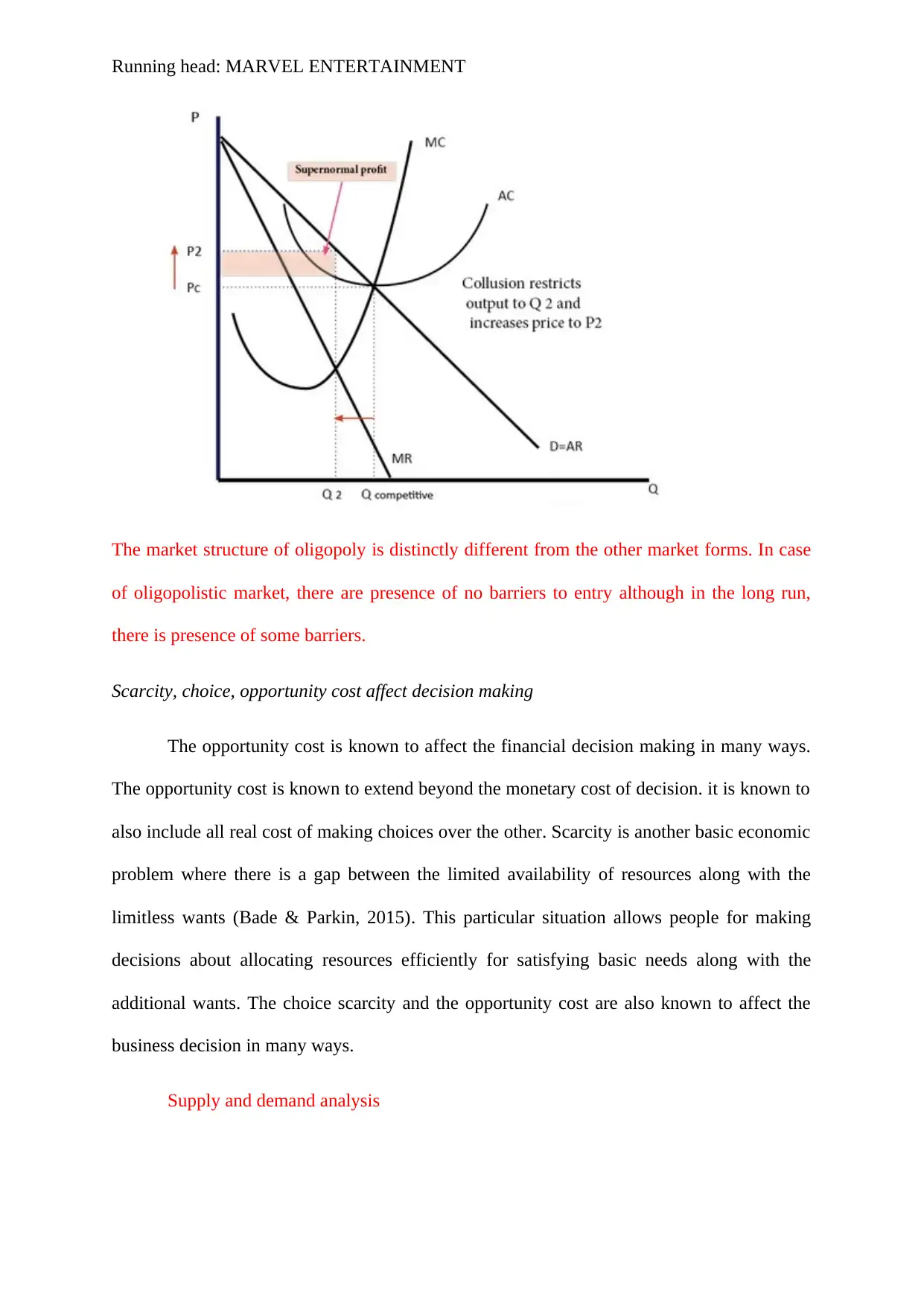
Running head: MARVEL ENTERTAINMENT
The market structure of oligopoly is distinctly different from the other market forms. In case
of oligopolistic market, there are presence of no barriers to entry although in the long run,
there is presence of some barriers.
Scarcity, choice, opportunity cost affect decision making
The opportunity cost is known to affect the financial decision making in many ways.
The opportunity cost is known to extend beyond the monetary cost of decision. it is known to
also include all real cost of making choices over the other. Scarcity is another basic economic
problem where there is a gap between the limited availability of resources along with the
limitless wants (Bade & Parkin, 2015). This particular situation allows people for making
decisions about allocating resources efficiently for satisfying basic needs along with the
additional wants. The choice scarcity and the opportunity cost are also known to affect the
business decision in many ways.
Supply and demand analysis
The market structure of oligopoly is distinctly different from the other market forms. In case
of oligopolistic market, there are presence of no barriers to entry although in the long run,
there is presence of some barriers.
Scarcity, choice, opportunity cost affect decision making
The opportunity cost is known to affect the financial decision making in many ways.
The opportunity cost is known to extend beyond the monetary cost of decision. it is known to
also include all real cost of making choices over the other. Scarcity is another basic economic
problem where there is a gap between the limited availability of resources along with the
limitless wants (Bade & Parkin, 2015). This particular situation allows people for making
decisions about allocating resources efficiently for satisfying basic needs along with the
additional wants. The choice scarcity and the opportunity cost are also known to affect the
business decision in many ways.
Supply and demand analysis
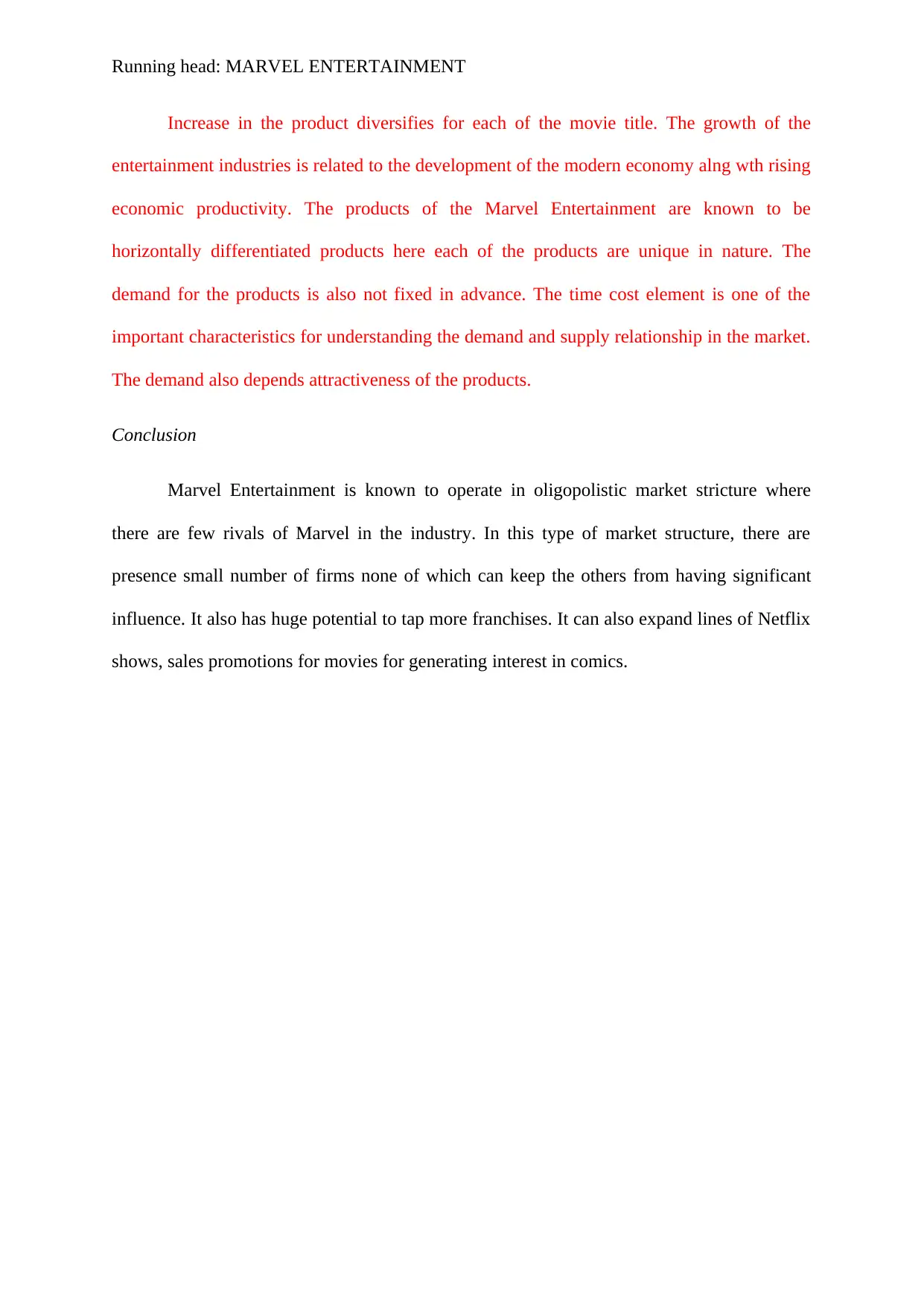
Running head: MARVEL ENTERTAINMENT
Increase in the product diversifies for each of the movie title. The growth of the
entertainment industries is related to the development of the modern economy alng wth rising
economic productivity. The products of the Marvel Entertainment are known to be
horizontally differentiated products here each of the products are unique in nature. The
demand for the products is also not fixed in advance. The time cost element is one of the
important characteristics for understanding the demand and supply relationship in the market.
The demand also depends attractiveness of the products.
Conclusion
Marvel Entertainment is known to operate in oligopolistic market stricture where
there are few rivals of Marvel in the industry. In this type of market structure, there are
presence small number of firms none of which can keep the others from having significant
influence. It also has huge potential to tap more franchises. It can also expand lines of Netflix
shows, sales promotions for movies for generating interest in comics.
Increase in the product diversifies for each of the movie title. The growth of the
entertainment industries is related to the development of the modern economy alng wth rising
economic productivity. The products of the Marvel Entertainment are known to be
horizontally differentiated products here each of the products are unique in nature. The
demand for the products is also not fixed in advance. The time cost element is one of the
important characteristics for understanding the demand and supply relationship in the market.
The demand also depends attractiveness of the products.
Conclusion
Marvel Entertainment is known to operate in oligopolistic market stricture where
there are few rivals of Marvel in the industry. In this type of market structure, there are
presence small number of firms none of which can keep the others from having significant
influence. It also has huge potential to tap more franchises. It can also expand lines of Netflix
shows, sales promotions for movies for generating interest in comics.
⊘ This is a preview!⊘
Do you want full access?
Subscribe today to unlock all pages.

Trusted by 1+ million students worldwide
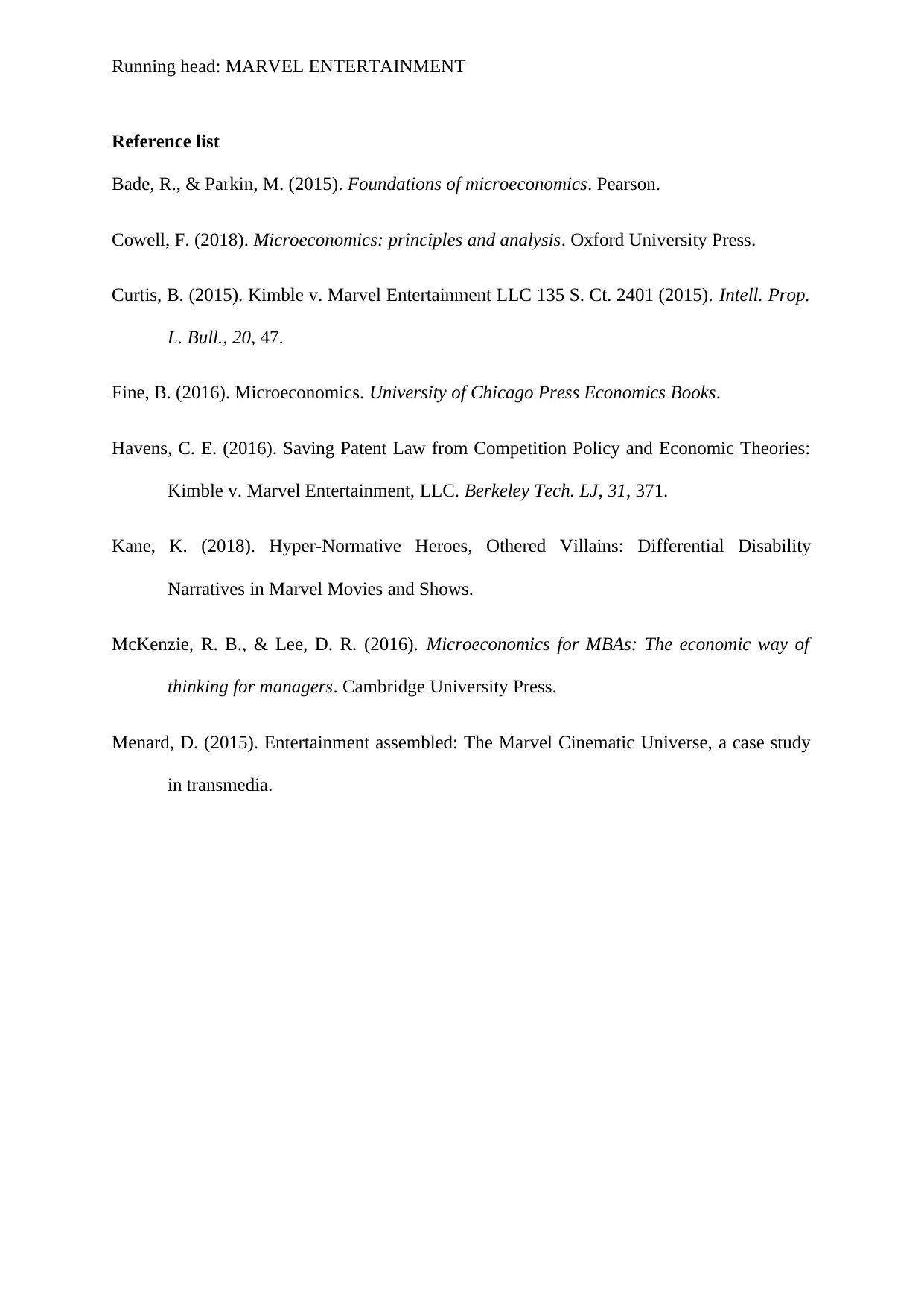
Running head: MARVEL ENTERTAINMENT
Reference list
Bade, R., & Parkin, M. (2015). Foundations of microeconomics. Pearson.
Cowell, F. (2018). Microeconomics: principles and analysis. Oxford University Press.
Curtis, B. (2015). Kimble v. Marvel Entertainment LLC 135 S. Ct. 2401 (2015). Intell. Prop.
L. Bull., 20, 47.
Fine, B. (2016). Microeconomics. University of Chicago Press Economics Books.
Havens, C. E. (2016). Saving Patent Law from Competition Policy and Economic Theories:
Kimble v. Marvel Entertainment, LLC. Berkeley Tech. LJ, 31, 371.
Kane, K. (2018). Hyper-Normative Heroes, Othered Villains: Differential Disability
Narratives in Marvel Movies and Shows.
McKenzie, R. B., & Lee, D. R. (2016). Microeconomics for MBAs: The economic way of
thinking for managers. Cambridge University Press.
Menard, D. (2015). Entertainment assembled: The Marvel Cinematic Universe, a case study
in transmedia.
Reference list
Bade, R., & Parkin, M. (2015). Foundations of microeconomics. Pearson.
Cowell, F. (2018). Microeconomics: principles and analysis. Oxford University Press.
Curtis, B. (2015). Kimble v. Marvel Entertainment LLC 135 S. Ct. 2401 (2015). Intell. Prop.
L. Bull., 20, 47.
Fine, B. (2016). Microeconomics. University of Chicago Press Economics Books.
Havens, C. E. (2016). Saving Patent Law from Competition Policy and Economic Theories:
Kimble v. Marvel Entertainment, LLC. Berkeley Tech. LJ, 31, 371.
Kane, K. (2018). Hyper-Normative Heroes, Othered Villains: Differential Disability
Narratives in Marvel Movies and Shows.
McKenzie, R. B., & Lee, D. R. (2016). Microeconomics for MBAs: The economic way of
thinking for managers. Cambridge University Press.
Menard, D. (2015). Entertainment assembled: The Marvel Cinematic Universe, a case study
in transmedia.
1 out of 7
Related Documents
Your All-in-One AI-Powered Toolkit for Academic Success.
+13062052269
info@desklib.com
Available 24*7 on WhatsApp / Email
![[object Object]](/_next/static/media/star-bottom.7253800d.svg)
Unlock your academic potential
Copyright © 2020–2025 A2Z Services. All Rights Reserved. Developed and managed by ZUCOL.




